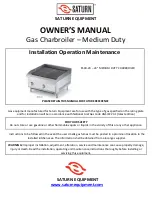
Fire Coil 85
(500-2000)
Page 7
the appliance has/have sufficient power to pull air and
vent properly when the following guidelines for
horizontal air and vent are followed (
see Table 2
).
NOTE:
The vent collar size is larger than the size of the
vent pipe that can be used. Vent collar size and
horizontal pipe diameters can be found in
Table 2
. The
larger vent collar size is to accommodate Category I
(vertical) vent systems.
NOTE:
When located on the same wall, the Fire Coil 85
combustion air intake terminal must be installed a minimum
of 12" (30cm) below the exhaust vent terminal and sep-
arated by a minimum of 36 inches (91cm) horizontally.
The air intake terminal must be installed high enough
to avoid blockage from snow, leaves and other debris.
SECTION 2.
Venting and Combustion Air
2.1 Combustion Air
Fire Coil 85 boilers and water heaters must have
provisions for combustion and ventilation air in
accordance with section 5.3, Air for Combustion and
Ventilation, of the National Fuel Gas Code, ANSI
Z223.1, or Sections 7.2, 7.3 or 7.4 of CSA B149.1,
Installation Codes, or applicable provisions of the local
building codes.
A Fire Coil 85 appliance may receive combustion
air from the space in which it is installed, or it can be
ducted directly to the unit from the outside. Ventilation
air must be provided in either case.
2.1.1 Combustion Air From Room
In the United States, the most common
requirements specify that the space shall communicate
with the outdoors in accordance with method 1 or 2,
which follow. Where ducts are used, they shall be of the
same cross-sectional area as the free area of the
openings to which they connect.
Method 1
: Two permanent openings, one
commencing within 12 inches (30 cm) of the top and one
commencing within 12 inches (30 cm) of the bottom, of
the enclosure shall be provided. The openings shall
communicate directly, or by ducts, with the outdoors or
spaces that freely communicate with the outdoors. When
directly communicating with the outdoors, or when
communicating to the outdoors through vertical ducts,
each opening shall have a minimum free area of 1 square
inch per 4000 BTU/hr (5.5 square cm/kW) of total input
rating of all equipment in the enclosure. When
communicating to the outdoors through horizontal ducts,
each opening shall have a minimum free area of not less
than 1 square inch per 2000 BTU/hr (11 square cm/kW)
of total input rating of all equipment in the enclosure.
Table 3
shows data for this sizing method, for each Fire
Coil 85 model.
Method 2
: One permanent opening, commencing
within 12 inches (30 cm) of the top of the enclosure, shall
be permitted. The opening shall directly communicate
with the outdoors or shall communicate through a vertical
or horizontal duct to the outdoors or spaces that directly
communicate with the outdoors and shall have a
minimum free area of 1 square inch per 3000 BTU/hr (7
square cm/kW) of the total input rating of all equipment
located in the enclosure. This opening must not be less
than the sum of the areas of all vent connectors in the
confined space.
Other methods of introducing combustion and
ventilation air are acceptable, providing they conform to
the requirements in the applicable codes listed above.
In Canada, consult local building and safety codes or,
in absence of such requirements, follow CSA B149.1.
2.1.2 Intake Combustion Air
The combustion air can be taken through the wall,
or through the roof. When taken from the wall, it must be
taken from out-of-doors by means of the NATCO
horizontal wall terminal (
see Table 2
). When taken from
the roof, a field-supplied rain cap or an elbow
arrangement must be used to prevent entry of rain water
(
see Figure 3
).
Use single-wall galvanized pipe, per
Table 4
, for
the combustion air intake (see
Table 2
for appropriate
size). Route the intake to the heater as directly as
possible. Seal all joints with tape. Provide adequate
hangers. The unit must not support the weight of the
combustion air intake pipe. Maximum linear pipe length
allowed is 50 feet (15.2m). Three elbows have been
calculated into the 50-foot (15.2m) linear run. Subtract
10 allowable linear feet (3.0m) for every additional
elbow used (
see Table 2
). When fewer than 3 elbows are
used, the maximum linear pipe length allowed is still 50
feet (15.2m).
The connection for the intake air pipe is on the
filter box. The Fire Coil 85 appliances have venting and
combustion air ducting attached to the top.
UNIT
EACH OPENING*
SIZE
SQUARE INCHES
SQUARE CM
500
125
807
750
188
1213
1000
250
1613
1250
313
2020
1500
375
2420
1750
438
2826
2000
500
3226
*Net Free Area in Square Inches / Square cm
Area indicated is for one of two openings; one at floor level and one
at the ceiling, so the total net free area could be double the figures
indicated.
This chart is for use when communicating directly with the outdoors.
For special conditions and alternate methods, refer to the latest
edition of ANSI Z223.1.
Note:
Check with louver manufacturers for net free area of louvers.
Correct for screen resistance to the net free area if a screen is
installed. Check all local codes applicable to combustion air.
Table 3. Combustion Air Openings.
Summary of Contents for Fire Coil 85
Page 23: ...Fire Coil 85 500 2000 Page 23 Figure 19 Fire Coil 85 500 750 Connection Diagram ...
Page 24: ...National Combustion Co Inc Page 24 Figure 20 Fire Coil 85 1000 Connection Diagram ...
Page 25: ...Fire Coil 85 500 2000 Page 25 Figure 21 Fire Coil 85 1250 2000 Connection Diagram ...
Page 37: ...Fire Coil 85 500 2000 Page 37 Figure 23 Sheet Metal Components ...
Page 38: ...National Combustion Co Inc Page 38 Figure 24 Internal Components ...








































